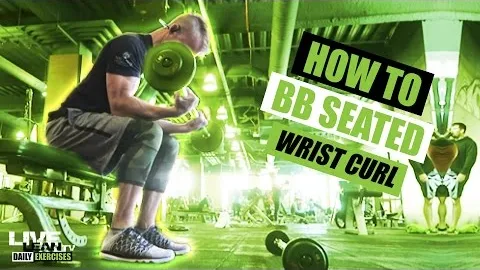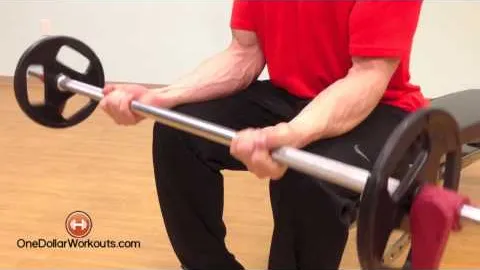







If you're looking to strengthen your forearms and improve your grip strength, the seated barbell wrist curl exercise is an excellent choice. This exercise specifically targets the wrist flexor muscles, which are responsible for bending your wrist downward. By including this exercise in your workout routine, you can develop stronger forearms, enhance your wrist stability, and even improve your performance in activities that require forearm strength, such as rock climbing or tennis.
The seated barbell wrist curl is a simple yet highly effective exercise that offers a multitude of benefits. Here are some key advantages of incorporating this exercise into your fitness routine:
The primary purpose of the seated barbell wrist curl exercise is to strengthen the muscles in your forearms. By repeatedly flexing your wrists against resistance, you create microtears in the muscle fibers, which, when repaired, contribute to stronger and more developed forearms.
Having a strong grip is advantageous in various sports and daily activities. Seated barbell wrist curls target the muscles responsible for wrist flexion, which are also involved in grip strength. Strengthening these muscles can lead to a significant improvement in your ability to grip and hold onto objects.
Maintaining proper wrist stability is crucial for preventing injuries and improving overall performance in activities that involve the use of your hands and forearms. Seated barbell wrist curls help strengthen the muscles and tendons surrounding the wrists, enhancing their stability and reducing the risk of strains or sprains.
One of the advantages of the seated barbell wrist curl exercise is its versatility. It can be easily modified to suit your fitness level and goals by adjusting the weight or using different variations such as using a barbell or dumbbells. This exercise allows for progressive overload, which is essential for continual strength gains.
Now that you understand the benefits of seated barbell wrist curls, let's discuss how to properly perform the exercise:
Begin by sitting on a flat bench with your feet flat on the ground and your knees bent at a 90-degree angle.
Hold a barbell with an underhand grip, palms facing upward. Your grip should be slightly wider than shoulder-width apart.
Rest your forearms on your thighs, with your wrists extending just beyond your knees and the barbell hanging freely in your hands.
Slowly lower the barbell by allowing your wrists to bend, keeping your forearms stationary. You should feel a stretch in your forearms as you descend.
Once your wrists are fully bent, exhale and slowly curl your wrists upward, lifting the barbell as high as comfortably possible.
Pause for a brief moment at the top of the movement, squeezing your forearms.
Inhale as you lower the barbell back down to the starting position, focusing on maintaining control and feeling the stretch in your forearms.
Repeat the movement for the desired number of repetitions.
To maximize the effectiveness of the seated barbell wrist curl exercise and minimize the risk of injury, follow these tips:
Start with a lighter weight to master the proper form and technique before gradually increasing the load.
Perform the exercise in a slow, controlled manner, focusing on the contraction and stretching of your forearms.
Keep your forearms stable throughout the movement, avoiding any unnecessary movements or bouncing of the barbell.
Maintain proper posture by keeping your back straight and shoulders relaxed.
It's essential to warm up your forearms and wrists before performing this exercise to prevent strain or injury. Wrist rotations, wrist flexor stretches, or other dynamic warm-up exercises can be beneficial.
To effectively incorporate seated barbell wrist curls into your workout routine, consider the following recommendations:
Frequency: Aim to perform this exercise two to three times per week with at least one day of rest in between sessions.
Repetitions and Sets: Begin with two to three sets of 8-12 repetitions. As you progress, you can gradually increase the number of sets or repetitions.
Progressive Overload: As you get stronger, gradually increase the weight you lift to continually challenge your muscles and promote further strength gains.
Balanced Training: Combine seated barbell wrist curls with exercises that target the extensor muscles of the forearms. This ensures balanced development and helps prevent muscle imbalances.
Consult a Fitness Professional: If you're new to this exercise or have any concerns about your form or technique, consider seeking guidance from a certified fitness professional to help you get started safely.
In conclusion, the seated barbell wrist curl exercise is an effective way to strengthen your forearms and improve your grip strength. By incorporating this exercise into your fitness routine and following proper form and technique, you can develop stronger wrists, enhance your overall forearm strength, and improve your performance in various activities that require forearm endurance and power. Start slowly and progress gradually, and you'll reap the benefits of this exercise for years to come.
If you're looking for a gym, fitness club or yoga studio, you've come to the right place.
You can find information about gyms in your area. Browse catalog of gyms and find gyms with classes which are you looking for.
On gym page you can find simple information like address, phone or website. You can find list of available classes. You can check availability of personal training or small group classes. On place page you can also see information about open hours.
You can find gyms near you with amenities, courts, studios and equipments.
Use our map to find gym at your city or district.
In Gym Navigator you can find list of exercises with movies for many body parts.
You can browse exercises catalog and find exercises the best of you.
You can also find exercises grouped into workout plans, which you can use to improve you body. Each routine show you exercises one by one and give you possibility to count you progress and count down rest time.